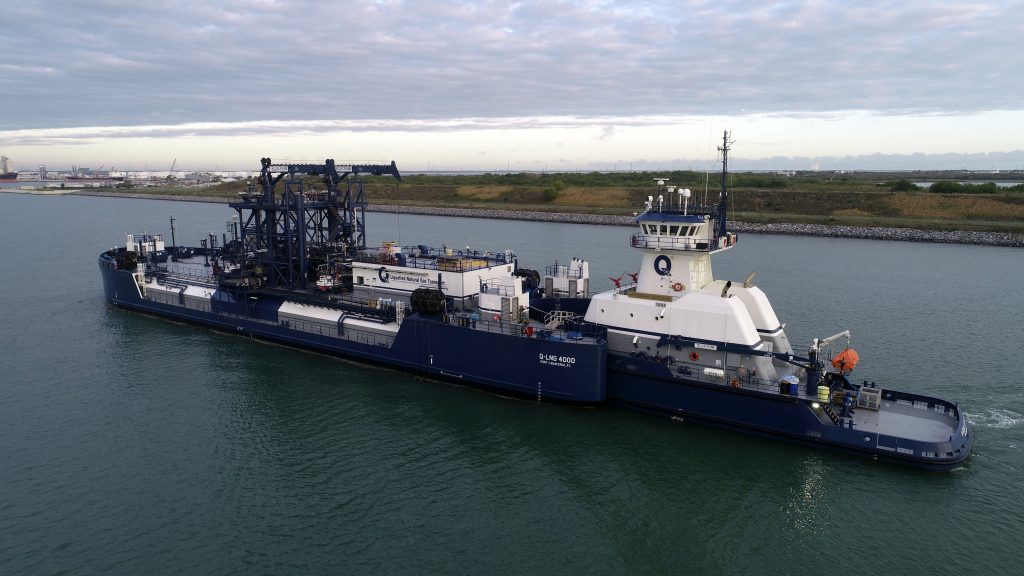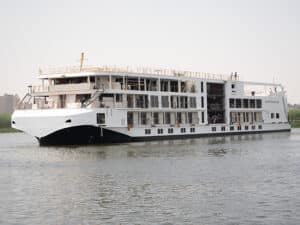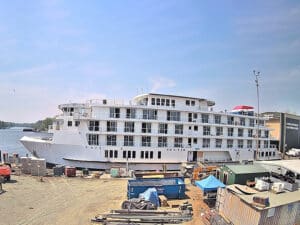
U.S. ports see silver linings despite pandemic
Written by Heather Ervin
Carnival has used the downtime to upgrade Port NOLA’s homeported Carnival Valor. Upon its return to Port NOLA, the Valor will be a brand new vessel. (Credit: Port NOLA)
Earlier last month, Port Canaveral in Florida marked a historic milestone in the safe, reliable transportation and delivery of liquefied natural gas (LNG) in North America as the Q-LNG 4000, a cutting-edge ship-to-ship articulated tug and bunker barge (ATB), arrived at America’s first LNG cruise port.
What does that have to do with cruise ships exactly? The purpose-built ATB will operate in Port Canaveral providing LNG fuel to cruise vessels, notably to Carnival Cruise Line’s LNG-powered Mardi Gras, which will homeport at Port Canaveral beginning this year. Built by Halter Marine for Shane Guidry’s Quality Liquefied Natural Gas Transport (Q-LNG), the ATB will carry enough supply of LNG to fuel two cruise ships, each for a seven-day itinerary.
“This project has been four years from concept to reality and we are excited to welcome the Q-LNG 4000 to fuel the next generation of cruise ships,” said Capt. John Murray, CEO of the port. “We have been working closely with our cruise partners, all the federal and state regulatory agencies, and industry leaders to promote this industry initiative.”
The 4,000-cubic-meter barge, constructed in cooperation with LNG fuel supplier Shell Trading Company, arrived at Port Canaveral recently for a sailing and berthing familiarization exercise. The vessel docked at Port Canaveral’s newly constructed Cruise Terminal 3, which was completed in June 2020 but not yet welcomed its first cruise passenger, with the global shutdown of the cruise industry due to the COVID pandemic.
“LNG is the fuel of the future, it’s clean, less expensive and made right here in the United States,” said Canaveral Port Authority Commission Chairman Rear Adm. Wayne Justice (USCG, Ret.). “We are proud to be part of making this safe secure move to the future in this region.”
The U.S. built, owned and crewed ATB, comprising a 324 foot long barge and a 128-foot tug, is the first Jones Act-compliant ATB built in the U.S. that is specifically designed to conduct LNG cargo and bunker operations. When the ATB is conducting its ship-to-ship on-water bunkering process of a cruise vessel, it will take place during the ship’s passenger debarking and embarking processes, like conventional refueling operations, and last approximately six to eight hours.

The Q-LNG 4000 will carry enough supply of LNG to fuel two cruise ships, each for a seven-day itinerary. (Credit: Canaveral Port Authority)
“We are proud to deliver the Q-LNG 4000 to Port Canaveral,” said Chad Verret, President of Q-LNG Transport. “LNG is the marine fuel of the future, it’s domestically sourced and in abundant supply in the U.S. We look to supplying not only cruise ships but trading vessels in the future.”
The barge will load LNG from a fuel distribution facility on Elba Island, Ga., then return to Georgia to refuel after each LNG bunkering operation in Port Canaveral. The ATB has a carrying capacity of up to 4,000 cubic meters of LNG, the equivalent of 1 million gallons of fuel.
Additionally, the Q-LNG 4000 fueling operations will be supported while it’s in Port Canaveral by the port’s newly acquired fireboat, which arrived in January. The purpose-built Marine Firefighting Rescue Vessel will be operated by Canaveral Fire Rescue to provide enhanced fire protection and response capabilities to serve the expanding maritime and commercial space industry operations at the port.
The good news for cruise ports doesn’t stop in Port Canaveral, however.
Port of Galveston Has Hope for 2021
In December, newly released cruise industry economic impact numbers for 2019 showed that the resumption of cruising will play a critical role in helping drive the Port of Galveston region’s economic recovery.
According to a recent report released by the Cruise Lines International Association (CLIA), the cruise industry generated $55.5 billion in economic activity in the United States, a 5.3% increase from 2018.
Moreover, growth in economic activity was accompanied by an increase in industry-supported jobs. According to the report, the cruise industry supported 436,600 American jobs paying $24.4 billion in wages in 2019 – 3.5% and 5.4% increases from 2018, respectively.
As the fourth most popular cruise port in North America and only cruise port in Texas, the Port of Galveston’s cruise activity contributed significantly to state and regional economies prior to the pandemic. The port saw growth in multiple areas related to its cruising activities, including direct expenditures, passenger embarkations, passenger and crew onshore visits, statewide wages, and more.
The port’s cruise business generates about 65% of the port’s annual revenue, allowing it to reinvest in business growth and infrastructure improvements to generate more jobs and economic benefits for the Galveston community.
These latest figures follow nearly 10 years of continued growth in the cruise industry, fueled by the rising popularity of cruise vacations. The report shows Galveston as one of the fastest growing cruise ports in the U.S. with embarkations more than doubled between 2012 and 2019.
More than 13.7 million passengers embarked on cruise ships from U.S. ports in 2019, up nearly 8% from 2018 and 26% from just five years ago.
But, of course, all of that has changed due to COVID.
While cruise operations remain suspended in the United States as a result of the pandemic, the Galveston Wharves is working with cruise industry leaders and local business and community partners for the safe, sustainable resumption of cruising in 2021.
The pandemic also impacted the schedule for the start of construction for a third cruise terminal. In 2020, Royal Caribbean asked for a one-year extension on its option to build a $100 million cruise terminal at the Port of Galveston.
The port said in January that it remains optimistic that plans will move forward and it will know the extension deadline by April.



